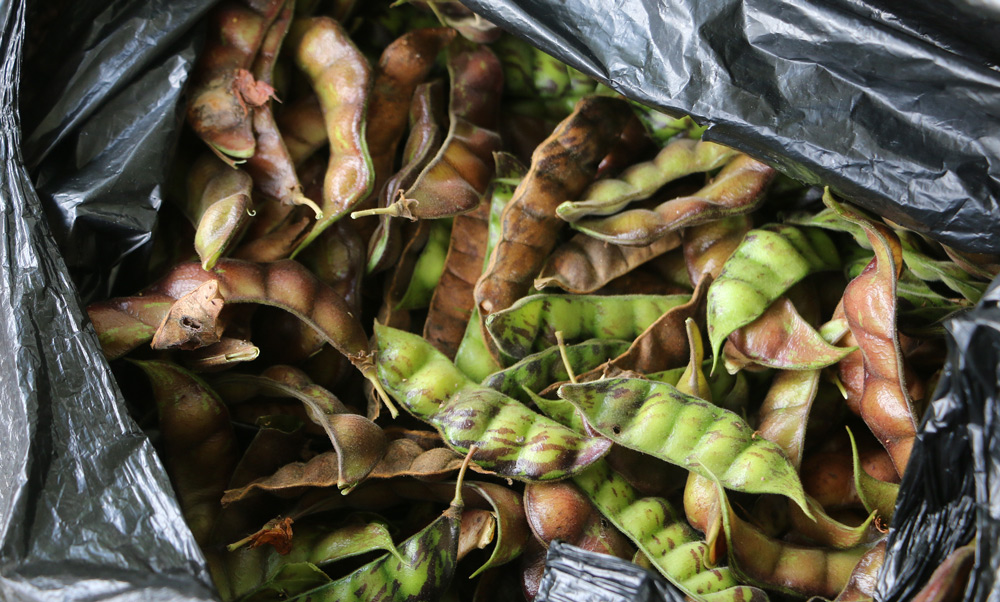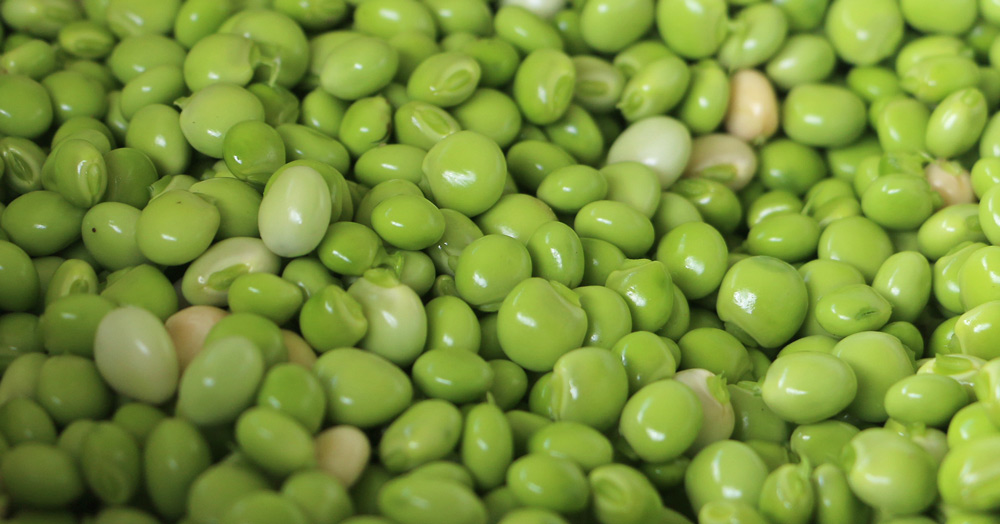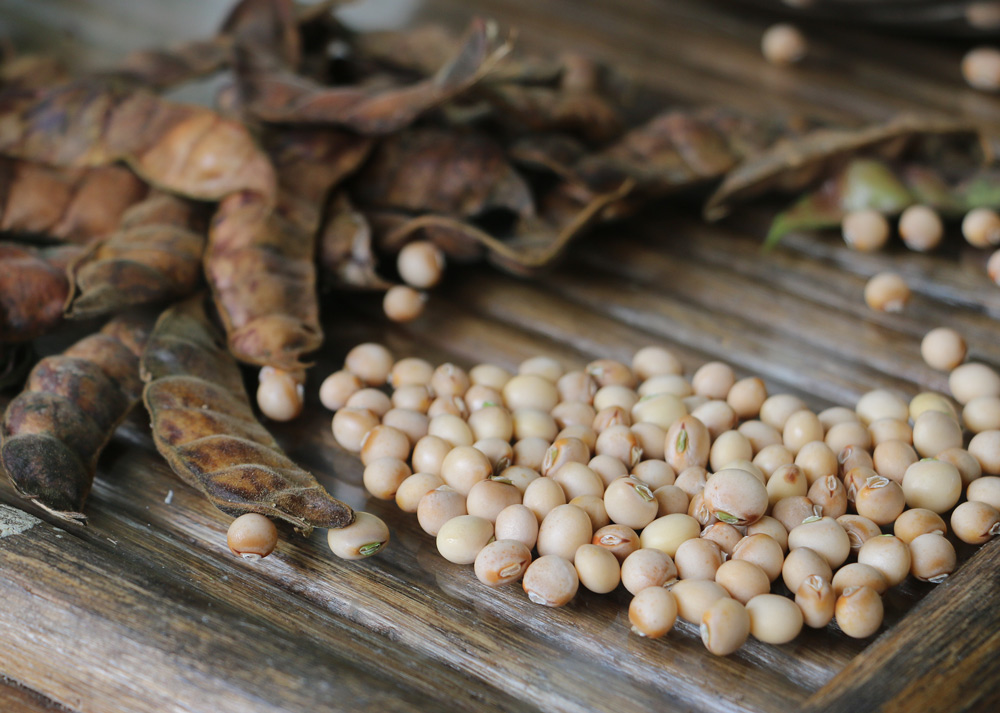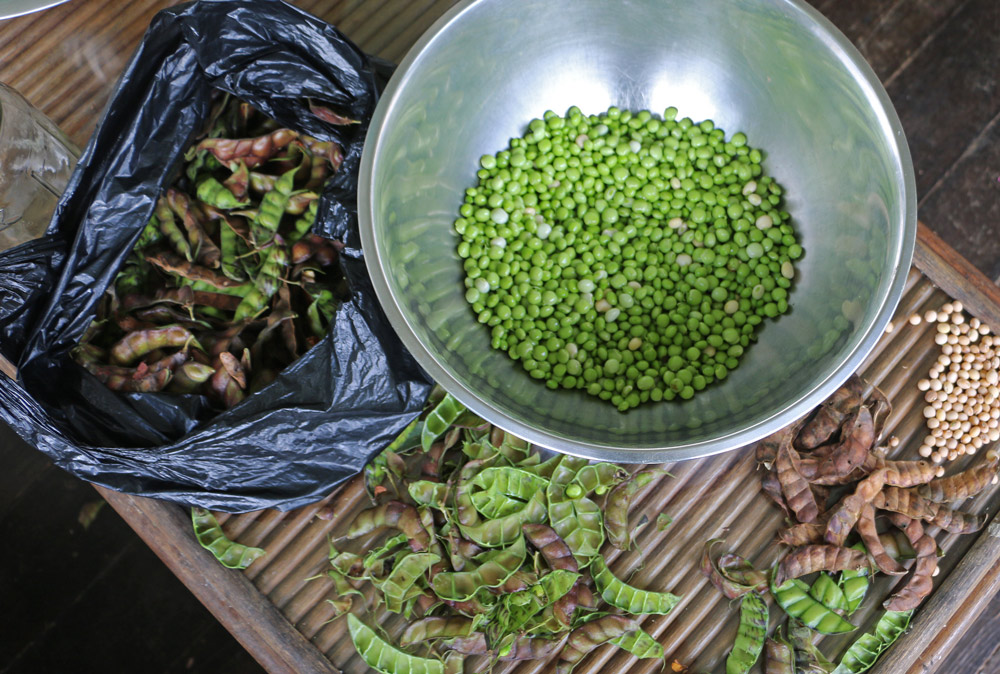Pigeon peas aren’t your typical garden pea. They are a big plant – you could even call them a small tree.
On Saturday Rachel and I walked down to the big patch of pigeon peas we planted last summer and found to our delight it was finally time to start picking.
We stuffed two shopping bags with pigeon pea pods.

There are at least two different varieties of pigeon peas growing on our plot. Some have reddish-brown pods, the other has green pods with blotchy red-brown patches.
If you leave the pods on the pigeon pea plants, they mature to a very good dried pea. If you pick them a little earlier, they can be shelled and eaten like regular garden peas.

We ended up with a few gallons of green peas after shelling. We also got some dried peas from pods that had already matured on the plants.

Last night we had green pigeon peas and rice mixed with saltfish for dinner. That was good. Hearty and healthy.
A Reader Interjects!
But… let me back up a bit. Reader James Paganacci wrote the following on my Survival Plant Profiles page a few days ago:
“I’m not sure if you have grown pigeon peas? They grow nicely in southern Florida (probably ok up north also?) and last a few years. They fix nitrogen and grow in sandy soils. Although they do better in rich organic soil. They don’t transplant very well, have to be careful with the root system or they go into shock and die. They are very easy to grow, prolific and produce a lot of edible seeds. I believe the amino acid profile is pretty good. This plant is a good addition to the survival plant list.”
Yes, I agree – so let’s make this a fully-fledged survival plant profile!
Pigeon Peas: An Excellent Survival Crop
I like having knowledge and success with a plant before I write a profile (though the recent survival plant profile I wrote on stinking toe trees was all based on research, not actual growing hours) which is why I waited for some time to write about pigeon peas.
In North Florida I attempted to grow pigeon peas multiple times and they always succumbed to frost before making more than a few peas. They’re day-length sensitive, which means they won’t flower until the fall and winter… and that spells doom for your crops.
In South Florida or anywhere with frost-free winters they’re a very good option as they fix nitrogen and can handle lousy soil.
Dry pigeon peas are found at Indian grocery stores. They grow readily. Sow them a couple of inches deep and wait a week or two. You can literally hack chunks out of your lawn and plant pigeon peas… and they’ll thrive.
As a further bonus, the hard wood of pigeon pea shrubs fuels rocket stoves like a boss.
Heck, this is another Swiss-army knife plant, so let’s make a list of its attributes.
Pigeon Pea Uses
Storable dry peas
Green peas good as a vegetable
Green manure
Drought-resistant source of calories
Windbreak
Erosion control
Good chop-and-drop for establishing food forests/mulching
Wood useful for firewood
Great forage for animals
Fixes nitrogen
Breaks up hard soil with its strong roots
Can be used to suppress weeds
Good road-side hedge
Impressive, eh? Yeah. They’re awesome.
How to Plant Pigeon Peas
In January Luis Quinones commented on one of my previous pigeon pea posts:
“In Puerto Rico mi grandma use to plant in the same hole at the same timeof planting bush beans sweet corn and pigeon peas. Both the bean and the pea will benefit the corn by fixing the nitrogen in the soil. Plus she fertilize one time only.
1. First to harvest was the beans. Feeding the plants and husk to the goats.
2. Second came the corn. Also feeding the leftovers to the goats and pigs.
3. Last one the pigeon pea. She will do 2 harvest one for green peas and last one for dry peas. Which she store in old one gallon milk only for later use that will last for a year. Then feeding the pigeon pea bushes to the goats.
This is like the 3 sisters system that the American Indian use to do. The difference is they used pole beans, corn and squash.
With the squash you don’t have to weed.
Find your 3 sisters combinations where one plant will benefit from the others.”
I like that idea. I just planted another round of pigeon peas in a new location and am thinking of adding squash/pumpkins to the plot to increase the overall yields. Pigeon peas are a perennial which will produce for a few years, long after the corn and pumpkins are gone.
You can see how I planted the new patch in the video I posted yesterday:
I’m not sure how the corn will do as we really didn’t loosen up much ground and the grass here is tough; however, I know the pigeon peas will take off.
You don’t need to interplant them, either. You can plant them alone. Got a rough patch of ground? Get it going with pigeon peas.
3-4′ spacing is perfect for pigeon peas, as they get big and branch out.
Pigeon Pea Allelopathy
You might not want to grow pigeon peas too close to some other crops, though. A local farmer told me that pigeon peas make other plants around them unhappy and that trees don’t like them.
I thought this was strange as pigeon peas are often recommended by permaculturalists as a great nitrogen-fixing species.
After a little research I discovered they are allelopathic.
According to everyone’s favorite agricultural company:
“As with many other legumes, pigeon pea has been shown to have Allelopathic properties which may inhibit the growth and performance of the following season’s crop. This should be taken into account if large fields are planted.”
I planted pigeon peas around some trees in my North Florida food forest but am unsure whether or not they had an effect on growth, positive or negative.
More tests are obviously needed, but for now I wouldn’t shy away from planting them in developing food forests. They certainly don’t seem to dampen the growth of corn.
Conclusion
Worries about allelopathy aside, I grew pigeon peas in an area of dead sand which had been rendered a mini-desert by goats. The peas thrived and the area was restored to a good gardening spot.
There are plenty of reasons to grow this excellent staple survival crop. It meets the test of being useful for many things, plus it tastes good and provides a good amount of protein unlike many other staples.
If you can grow pigeon peas, do it!
You’ll find more info at Infogalactic.
And at Tropical Permaculture.
And at Kew Royal Botanic Gardens.
SPUDOMETER RATING:

Name: Pigeon Pea, gunga pea, sometimes just “peas”
Latin Name: Cajanus cajan
Type: Shrub/small tree
Nitrogen Fixer: Yes
Medicinal: Some uses claimed
Cold-hardy: No
Exposure: Full sun
Part Used: Peas, leaves for forage and mulch, stems for cooking wood
Propagation: Seed
Taste: Good
Method of preparation: Green peas steamed or boiled. Dry peas boiled until soft. Peas can also be sprouted and used.
Storability: Dry peas, very good. Green peas, frozen.
Ease of growing: Totally crazy easy
Nutrition: Good. High in protein.
Recognizability: Moderate
Availability: Moderate


29 comments
I’m always glad to see new additions to the Survival Plant Profiles page. It’s been highly influential in my central Florida gardening.
I can vouch for pigeon peas. I grow them in a subtropical/temperate/arid climate. We cross zones, depending what the seasons decide to do. So pigeon peas have a pretty good reach in climate zones. I’ve had light frost take off the tips sometimes. but they grow back, busher, once the rains and warmer temps arrive.
Pigeon peas are great for chicken feed. Plant them around the coop. Because their tap roots are long and fleshy, they can survive the most tenacious scratching from hens. They’ll need protecting in the first year though, depending how long your growing seasons are. I manage 4 to 5 years with my trees, then they die. But the wood is terrific for running through my blunt shredder. Pigeon Pea is the best wood for the chipper, and it breaks down so easily into soil.
I also found out (quite by accident) they are a substitute feed for the kangaroos in our area, when the grass isn’t growing. So they also make good fodder for ruminants too. Do the wandering cows, prune your trees when the grass isn’t growing? Or do they have such an abundance of fallen mangoes, they wouldn’t bother with the protein in the pigeon peas?
I have two pigeon pea plants and am having a major issue. I see bunches of pods on the plant and wait for them to fill up. But something comes around and eats the fully mature pea and to this day cannot figure out what’s happening. Any suggestions
It’s squirrels. I never had a problem with squirrels before, but now I have one renegade squirrel who jumps on the limbs, slides down and strips them, then eats the peas off the ground. I finally got sick of it, so I cut the tree back, since he had stripped most of the peas anyway. He’s still looking for something to eat there. I planted some more pigeon peas in a place where he can eat them to his heart’s content and leave mine alone.
I’ve been wanting to grow pigeon peas since we tasted them at a food & wine festival – and then I read they are a nitrogen fixer/soil builder. I have some sections of my Orlando yard that are straight sand, and I’m looking to build the soil. The water stands there when it rains and doesn’t soak in – I hate it! It also creates lots of dust. I’ve looked online for pigeon peas and haven’t found any – I’ll try to look around here for an Indian grocery store! Thank you!
I can say from my experience that pigeon peas definitely DID have an effect on my guava tree. I planted 2 guavas (same age) within a few yards of each other…one took off magnificently, the second I planted pigeon peas around adn while the pigeon peas thrived the guava never fruited at all. It stayed a little more stunted than the other as well. So now I know why!
Other than that I am a pretty big fan of pigeon peas.
Cajanus Cajan is also called as tuvar dal / Toor Dal.
India uses them for daily food . to make stews/lentil soup. its protein source.
Do you sell your seeds/harvest ?
Planted a some igeon pover six months but it has not bear any fruit. Would it still bear???
Yes, but it’s probably going to wait until fall to do so. They are day-length sensitive – they’ll wait until the days shorten before they bloom.
David points out that it is day light sensitive.
Has anyone tried blanketing it for a few days at a time to trick it into budding out earlier?
Michael,
Now there are Northern Adapted pigeon peas! Yea. Now more of us can plant them! https://trueloveseeds.com/products/northern-adapted-pigeon-peas-gandules
Thank you, Pam.
I have a pigeon pea plant in my garden and I was wondering if you could help me with a question I have. I live in Massachusetts and we can get harsh winters is there a way I can protect it outside or if I can dig it up and put in a pot and bring it inside my house so it can keep growing and then in the spring bring it back out and replant it or leave it in the pot so it keeps growing. Sorry that it seems to be a stupid question but it is my first time growing a pigeon pea plant.
I planted pigeon peas here in N. Florida (Gainesville) a few years ago. We had a mild winter that year, and both of them thrived and came back strong in the spring. They bloomed in late winter, early spring and gave me a great harvest. The next year, we were predicted to have a harsh winter, so I cut them back to about 2 feet and covered them with large pots stuffed full of leaves. Both survived and came back out and grew well, blooming in the fall. I had heard that the production goes down significantly in year three, so I didn’t protect them, but I did plant some seeds next to them so I could use the dead trunks as stakes (the plants tend to fall over when young.) As expected, the trees froze, but the seeds sprouted in the spring and lived two years using the same method I used before. I have two plants growing now, one next to an elderberry which is growing like mad, and one volunteer inside my courtyard that isn’t growing so well. I’m moving next summer, so I’ll protect the smaller one this winter hoping for spring blooms, but if it freezes, so be it.
I love that the pollinators love them. I live in SW Gainesville in a high-density population area and have a hard time getting pollinators, but the carpenter bees love my pigeon peas.
[…] recently commented on my pigeon pea survival profile page about her success in growing pigeon peas in North […]
[…] recently commented on my pigeon pea survival profile page about her success in growing pigeon peas in North […]
Do pigeon peas give you gas when consumed. I’m having trouble finding the answer to this.
Yes. They are not very digestible.
We have been long-time consumers of pigeon peas, a staple back in Trinidad and now growing our own. Never had any issue with gas from them, nor does anyone in my family. We cook well in broth + onion (pre-cooked/carmelized) + soy +thyme/sage/bay. Don’t know if the preparation method impacts digestion or not.
If you soak and then sprout your peas before cooking, they are more easily digested. I sprout pinto beans before cooking, they don’t cause any gas. They taste the same. It removes the anti nutrients. I also sprout split peas before cooking. Works great.
Stupid question, but how do i get started? Do you just take dry beans and plant them?
I have planted them from the store and they’ve worked, yes.
Thanks for all your good info. I saw pigeon peas for the first time in Fiji where they are grown by the Indian population. Was thrilled when I saw a baby plant at Home Depot here in Honolulu for the first time. The plant is huge now so I came here to find out when I was actually going to get a crop. Apparently the Puerto Rican community eat them a lot here….with rice. Recently I saw a chicken coop run with a big planting of pigeon peas and I thought that a great idea. The chickens loved the shade from the plant and when those peas start popping they will really be happy. Plus all that chicken poop and nitrogen from roots should really prep the area for a future garden.
Very cool.
Are the leaves edible? I have heard that they can be fed to chickens.
I interplanted some pigeon pea in my tree rows as a nitrogen fixer and to provide some additional shade for the fruit trees. Placed three seeds per hole some 40 – 50cm apart and was pleased to see many sprout very quickly. in some cases only one sprouted, in others two or all three came up and are now already about 10cm tall. question is should I thin out the extra plants or let all of them go and let nature sort it out?
I usually let them all grow.
[…] recently commented on my pigeon pea survival profile page about her success in growing pigeon peas in North […]
Guys, help. I’ve got a 5′ tall pigeon pea growing about 7 ft away from a struggling peach tree. The pigeon pea is doing great, altho I still haven’t got any flowers or peas from it yet??? Why?? (Its 12 months old)
But the peach hasn’t grown at all. The pigeon pea is 5 ft wide and 5 ft tall. Big green leaves.
I planted it to fix nitrogen for the peach and the (now dead) little orange on the other side of it.
Is it tue pigeon peas fault? Do I chop it down to try to save the peach? Or is 7 ft away sufficiently far away from it? Is it fixing nitrogen for it, or killing rival trees with allelopathy?
I am caught in the doldrums of indecision. Anyone else experience pigeon peas planted with young peach trees? Any advice?
Comments are closed.